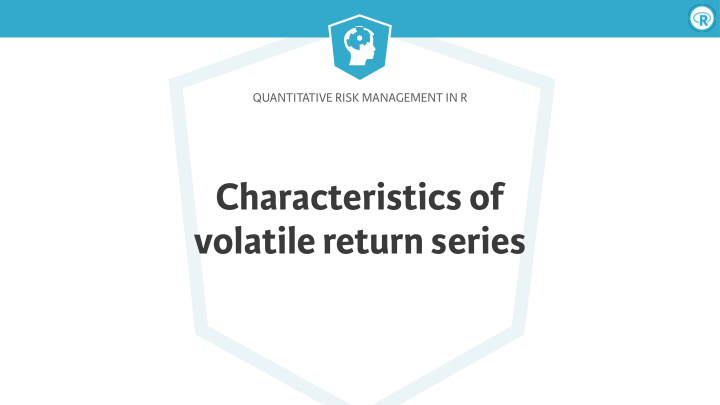



QUANTITATIVE RISK MANAGEMENT IN R Characteristics of volatile return series
Quantitative Risk Management in R Log-returns compared with iid data ● Can financial returns be modeled as independent and identically distributed (iid)? ● Random walk model for log asset prices ● Implies that future price behavior cannot be predicted ● Instructive to compare real returns with iid data ● Real returns o � en show volatility clustering
QUANTITATIVE RISK MANAGEMENT IN R Let’s practice!
QUANTITATIVE RISK MANAGEMENT IN R Estimating serial correlation
Quantitative Risk Management in R Sample autocorrelations ● Sample autocorrelation function (acf) measures correlation between variables separated by lag (k) ● Stationarity is implicitly assumed: ● Expected return constant over time ● Variance of return distribution always the same ● Correlation between returns k apart always the same Notation for sample autocorrelation: ˆ ρ ( k ) ●
Quantitative Risk Management in R The sample acf plot or correlogram > acf(ftse)
Quantitative Risk Management in R The sample acf plot or correlogram > acf(abs(ftse))
QUANTITATIVE RISK MANAGEMENT IN R Let’s practice!
QUANTITATIVE RISK MANAGEMENT IN R The Ljung-Box test
Quantitative Risk Management in R Testing the iid hypothesis with the Ljung-Box test ● Numerical test calculated from squared sample autocorrelations up to certain lag ● Compared with chi-squared distribution with k degrees of freedom (df) ● Should also be carried out on absolute returns k ρ ( j ) 2 ˆ X 2 = n ( n + 2) X n − j j =1
Quantitative Risk Management in R Example of Ljung-Box test > Box.test(ftse, lag = 10, type = "Ljung") Box-Ljung test data: ftse X-squared = 41.602, df = 10, p-value = 8.827e-06 > Box.test(abs(ftse), lag = 10, type = "Ljung") Box-Ljung test data: abs(ftse) X-squared = 314.62, df = 10, p-value < 2.2e-16
Quantitative Risk Management in R Applying Ljung-Box to longer-interval returns > ftse_w <- apply.weekly(ftse, FUN = sum) > head(ftse_w, n = 3) ^FTSE 2008-01-04 -0.01693075 2008-01-11 -0.02334674 2008-01-18 -0.04963134 > Box.test(ftse_w, lag = 10, type = "Ljung") Box-Ljung test data: ftse_w X-squared = 18.11, df = 10, p-value = 0.05314 > Box.test(abs(ftse_w), lag = 10, type = "Ljung") Box-Ljung test data: abs(ftse_w) X-squared = 34.307, df = 10, p-value = 0.0001638
QUANTITATIVE RISK MANAGEMENT IN R Let’s practice!
QUANTITATIVE RISK MANAGEMENT IN R Looking at the extreme in financial time series
Quantitative Risk Management in R Extracting the extreme of return series ● Extract the most extreme negative log-returns exceeding 0.025 > ftse <- diff(log(FTSE))["1991-01-02/2010-12-31"] > ftse_losses <- -ftse > ftse_extremes <- ftse_losses[ftse_losses > 0.025] > head(ftse_extremes) ^FTSE 1991-08-19 0.03119501 1992-10-05 0.04139899 1997-08-15 0.02546526 1997-10-23 0.03102717 > length(ftse_extremes) [1] 115 ● There are none from 1993-1996!
Quantitative Risk Management in R Plo � ing the extremes values > plot(ftse_extremes, type = "h", auto.grid = FALSE)
QUANTITATIVE RISK MANAGEMENT IN R Let’s practice!
QUANTITATIVE RISK MANAGEMENT IN R The stylized facts of return series
Quantitative Risk Management in R The stylized facts 1. Return series are heavier-tailed than normal, or leptokurtic 2. The volatility of return series appears to vary over time 3. Return series show relatively li � le serial correlation 4. Series of absolute returns show profound serial correlation 5. Extreme returns appear in clusters 6. Returns aggregated over longer periods tend to become more normal and less serially dependent
QUANTITATIVE RISK MANAGEMENT IN R Let’s practice!
Recommend
More recommend